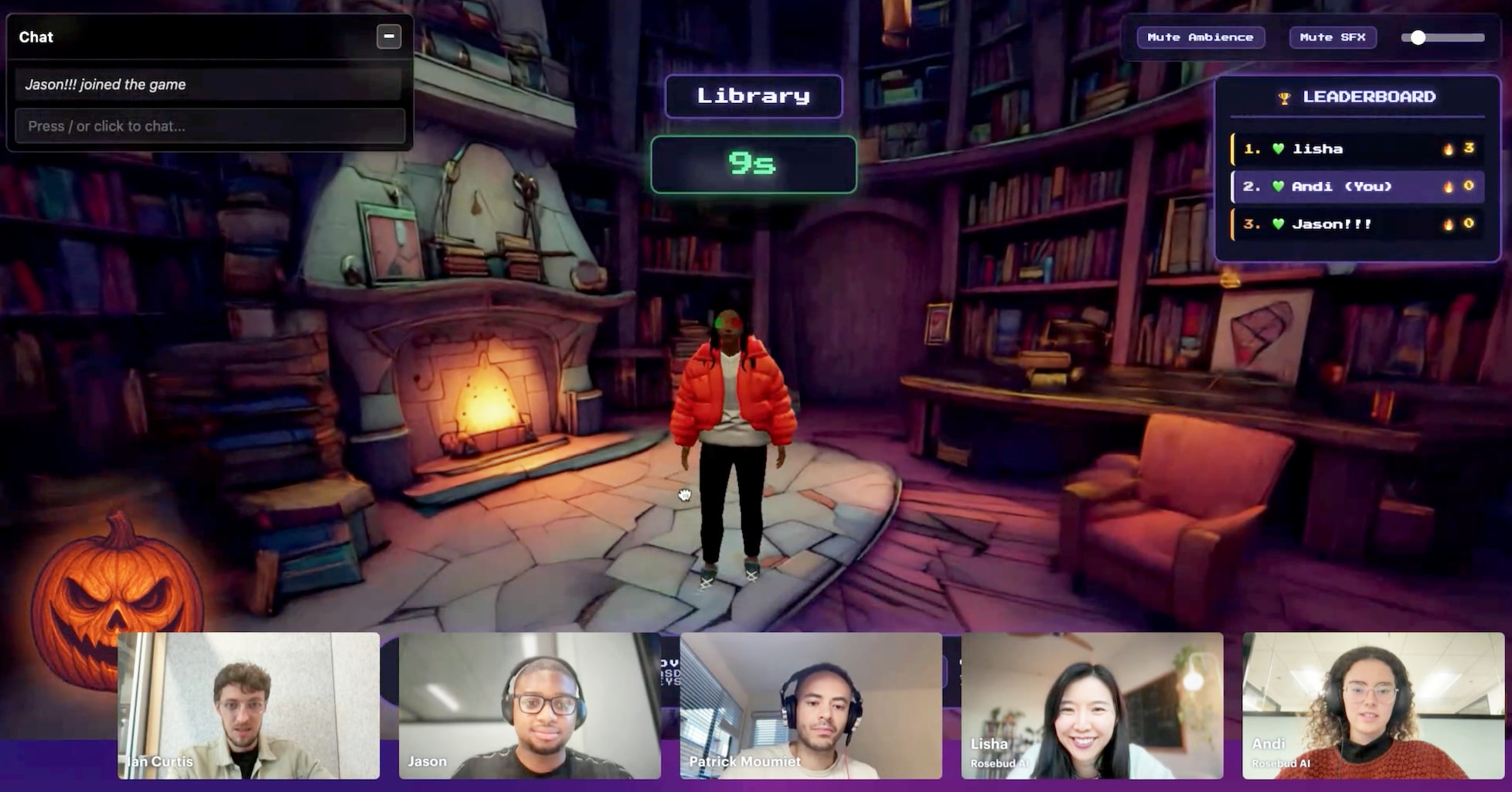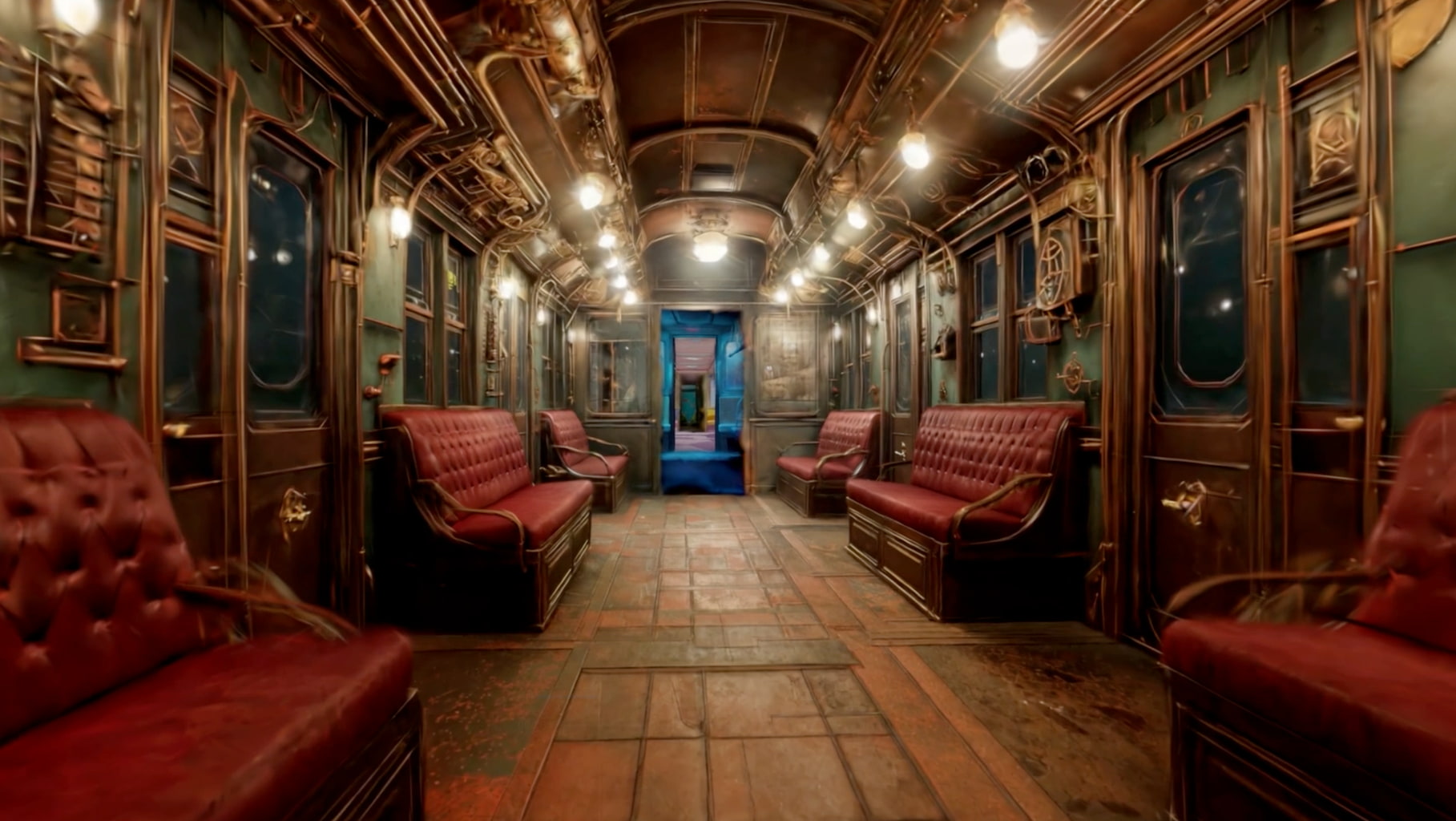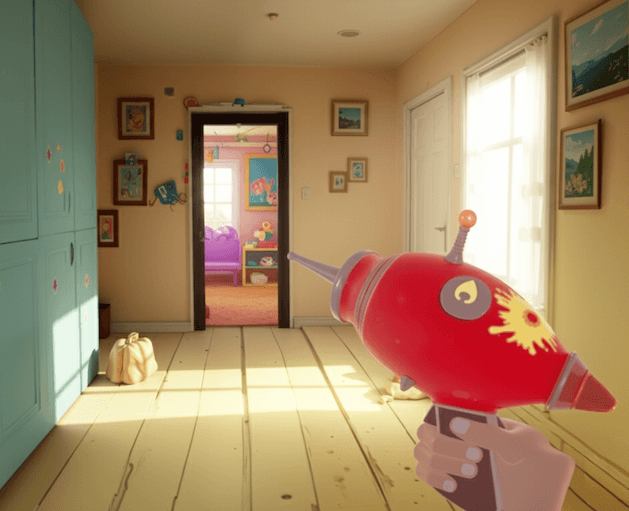Sep 16, 2025How Rosebud and Marble combine generative worlds and AI-assisted game tools to make creating and sharing playable 3D spaces faster, easier, and more collaborative.
From World Generation to Multiplayer: Rosebud x Marble
Collaboration Overview
RosebudAI is a platform designed to make game creation as intuitive as play itself. Using natural language prompts, creators can build games, generate art, and add mechanics without traditional coding.
To explore how generative 3D worlds could extend this workflow, the Rosebud team collaborated with Marble on a creative experiment — testing how Marble’s spatial generation tools could be used directly within Rosebud’s game creation pipeline.
Together, they also explored how these generative worlds could become shared play spaces: environments where multiple players can explore and interact together inside the same AI-generated world.
The goal was to demonstrate what becomes possible when world generation meets game generation — fast, accessible, and immersive experiences that empower anyone to build and explore 3D games without needing a traditional production team.
With Marble, we can create magical, explorable worlds and empower a wider community of game makers.
The Rosebud AI Team
The Project
To showcase this collaboration, Rosebud’s developers built a prototype game that demonstrates the entire pipeline — from world generation in Marble to live gameplay inside Rosebud.
Several small prototypes were created during the collaboration, but the main showcase was a multiplayer Simon Says-style game that demonstrated how a Marble-generated world could become a shared, interactive play space.
The concept was simple: let anyone build a complete and visually stunning 3D game from a single image or text prompt.
The same workflow also laid the foundation for multiplayer play — allowing multiple players to enter and explore a single Marble-generated environment together.
In the demo, creators used Marble to generate an immersive 3D scene, then export and upload it into a Rosebud template. From there, Rosie, Rosebud’s AI assistant, added game mechanics, objectives, and interactions — turning the generated world into a playable experience.
This workflow shows how Marble and Rosebud can work together to enable rapid creation of high-quality, explorable games without traditional modeling or scripting. The process mirrors what developers might do with a game engine — but powered entirely by generative tools.
These worlds can then be published as solo- or multiplayer sessions, allowing creators to share their creations with others to play together, even though editing remains a solo experience.

Creative & Technical Process
The integration between Marble and Rosebud was designed to be simple, modular, and accessible for creators at all skill levels.
- Scene Generation: 3D environments were created in Marble from single images or text prompts. The outputs were Gaussian splat scenes containing depth, geometry, and lighting data.
- Stitching & Composition: Multiple Marble scenes were combined in the Marble Composer tool to create continuous environments. Once assembled, a mesh-based collider was generated from the stitched scene and exported as a
.glbfile. - Physics Integration: The exported collider mesh was then imported into RosebudAI and used for physics-based collision within gameplay. This allowed the splat-based worlds to support movement, object interaction, and environmental logic inside Rosebud’s game engine.
- Export and Upload: The visual splat scenes and their corresponding collider meshes were uploaded into Rosebud’s game templates, which handle camera, controls, and game logic.
- Game Assembly: Inside Rosebud, creators used Rosie, the AI assistant, to add interactivity — including player mechanics, environmental triggers, and VFX. Multiplayer logic, such as synchronized movement, shared objectives, or cooperative gameplay, can be layered into these templates, making it simple to turn a single-player experience into a shared one.
- Ease of Use: Marble-generated assets function like any other in Rosebud: they can be remixed, swapped, or modified.
- New Features Developed: During the collaboration, Rosebud introduced the World Labs chip, a collection of prebuilt templates that streamline remixing and collaborative creation.
This workflow demonstrated how Marble’s splat-based environments can be adapted for real-time physics and interaction — bridging generative worldbuilding with gameplay systems.

Results & Impact
The collaboration demonstrated how generative 3D worldbuilding can fit naturally into game development workflows — even on platforms aimed at non-technical users.
While the workflow still involved several manual steps — such as exporting, stitching, and physics setup — the project proved that these connections could be automated in future iterations.
With Marble, Rosebud creators were able to:
- Generate detailed 3D environments.
- Quickly see results in Rosebud without manual modeling or texturing.
- Iterate on both visuals and gameplay within one creative loop.
The experiment also highlighted the flexibility of Gaussian splats as real-time assets. Instead of being static geometry, the splats served as interactive environments — offering performance and visual quality comparable to traditional 3D pipelines.
For Rosebud, Marble provided a new layer of creative capability. For Marble, the project demonstrated how its worlds can live inside other ecosystems — serving as creative foundations for generative game design and interactive play.
Together, they point toward a new form of creative expression: building worlds that others can step into, play through, and experience together.
Multiplayer Worlds
One of the most exciting directions unlocked by combining Rosebud and Marble is multiplayer worldbuilding — shared spaces where creators and players can interact inside the same generative 3D environments.
Because Marble’s worlds are generated as real-time, explorable scenes, they can serve as dynamic backdrops for multiplayer games built in Rosebud. Each player can join the same space, explore together, and even collaborate on shaping it through chatting, turning single-player creativity into collective play.
Inside Rosebud, multiplayer features make these environments come alive:
- Collaborative exploration: Players can enter the same Marble-generated world, discovering different regions or completing shared objectives together.
- Real-time creativity: Game creators can use Rosie to modify the world as others play, dynamically adjusting lighting, obstacles, or mechanics — effectively “live directing” a game.
- Persistent worlds: By integrating multiplayer logic into Rosebud templates, a generated scene can become a lasting shared world that evolves with its community.
Immersive spaces become even more powerful when they’re inhabited. Together, Rosebud and Marble make it possible for creators to not only design their own universes, but to invite others inside them — bridging creation, collaboration, and play.

Looking Ahead
Following the success of the demo, both teams are continuing to explore new ways to connect their tools and workflows. Future experiments include:
- Native Marble integration inside Rosebud, so creators can generate splats directly without manual export.
- Multiplayer and VR experiences built with Marble environments as shared spaces.
- Expanded World Labs templates for faster remixing and collaborative creation.
- Performance improvements for larger, stitched Marble scenes.
Rosebud is also testing workflows where a user can start by generating a splat inside Marble, then use Rosebud to build game logic — creating a seamless bridge between imagination and play.
This collaboration showed how naturally Marble fits into platforms like Rosebud. You can create a world, add gameplay, and share it — all within minutes. That’s the future of interactive creation.
Jason Agbebaku, Rosebud
Read More
Sep 16, 2025
Gaussian Mansion: Creating Playable Worlds with Marble
Integrating spatial generation, AI-driven modeling, and Unreal Engine to streamline 3D world production from concept art to gameplay.

Sep 16, 2025
Splat World: Exploring New Dimensions of Gaussian Splatting in VR
How one developer turned Gaussian splats into a new language for building interactive worlds.
